8 Effective Tips for Quick Online Reputation Repair [2025]
Table of contents
It’s October 20, 2024, and the presidential election campaign in the USA is at top speed. That day, Donald Trump made a strategic move to mock Kamala Harris’s claim about having worked at McDonald’s and hired himself for one day in the fast-food restaurant.
People on the Internet go CRAZY, and McDonald’s faces the backlash.
On that day, McDonald’s received more negative mentions than usual over SIX TIMES, reaching almost SIX TIMES as many people as normal. Trump’s opponents were FURIOUS…
As a result, McDonald’s Reputation Score reached -71.
It’s too late now. The fast food chain got involved in a political dispute, which backfired. Now, McDonald’s can only plan an online reputation repair strategy to get off the tiger’s back.
Online reputation repair means taking action when a personal reputation or brand’s image on the Internet is negative. This repair aims to restore a good online reputation by addressing the issue and endorsing positive content.
Did you know that 90% of consumers don’t want to use a business with a bad reputation?
Thus, your brand must monitor its reputation and act fast when things start going wrong.
In this article, you’ll find 8 tips on effective online reputation repair strategies.
Let’s transform digital challenges into opportunities to improve your brand reputation and regain customer trust.
What indicates online brand reputation damage?
Recognizing early damage signs of an online brand’s reputation is crucial in today’s digital world.
This way, you can prevent escalation and save your business reputation from a serious PR crisis.
Watch out for the 4 factors below, which might be an early sign that you must repair your online reputation.
01 Anomaly
Anomaly Detection is an innovative feature that will save your life!
It acts like a guard for your business’s online performance, letting you know when an abnormal situation happens.
It focuses on sudden peaks in brand reach and mentions volume, which can signify controversy around your brand.

I used this feature to discover the case study I presented in the introduction.
Imagine discovering a similar wave of negative press releases and user-generated content for your brand…
Better safe than sorry. Monitor anomalies around your brand.
02 Reputation Score
The Reputation Score is typically a metric used by reputation management services and media monitoring tools to quantify a brand’s overall online reputation.
This metric, based on sentiment and reach analysis and ranging from -100 to 100, defines your brand’s online reputation.
A low Reputation Score is a significant indicator of brand reputation damage, implying that you might need an online reputation repair service.

As you can see, McDonald’s digital reputation is at -71, with a noticeable decline after the negative feedback surged on October 20.
This is an important sign that McDonald’s might need help from reputation repair services to rebuild its positive online reputation.
Pro tip: The Reputation Score also measures the effects of your reputation repair efforts. This way, you’ll see if your actions succeed in rebuilding your positive online presence.
03 Sentiment
Increased negative comments and online reviews generate negative sentiment, signaling that a brand’s reputation is threatened.
Negative mentions affect public perception and have long-term consequences for customer loyalty, financial performance, brand health, and online visibility.
That’s why it’s essential to pay attention to any sentiment changes.

04 Emotion Analysis
Emotions heavily influence consumer behavior.
Increased negative emotions can sway potential customers to avoid the brand and seek alternatives.
Tracking customers’ emotions about your brand and products can help detect a crisis early on. Online reputation management tools can help you do that.
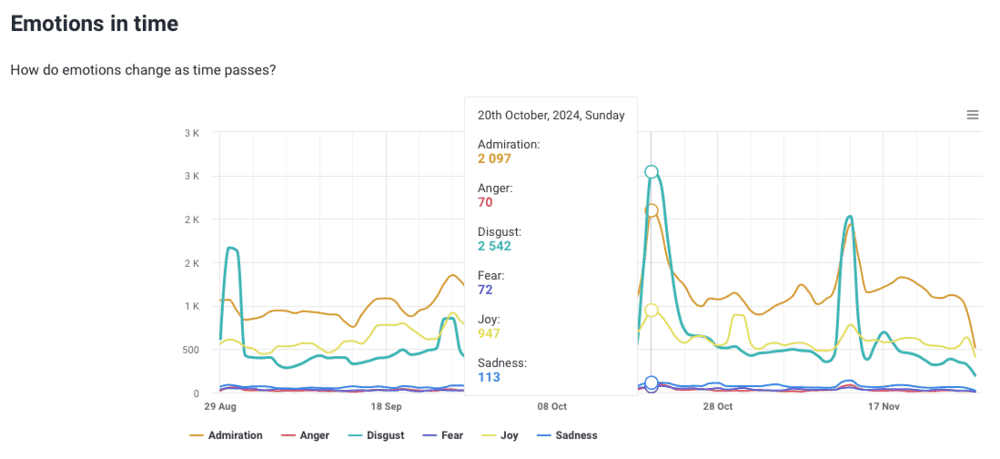
Manage your online reputation! Monitor brand online!
How to repair your online reputation? 8 tips
Before we move to the online reputation repair tips, you need to know how bad the situation is.
Compare your company’s reputation between periods for a broad picture of the issue.
You can use Brand24 to do it effortlessly. Just choose the periods you’re interested in, and the tool will do the rest.
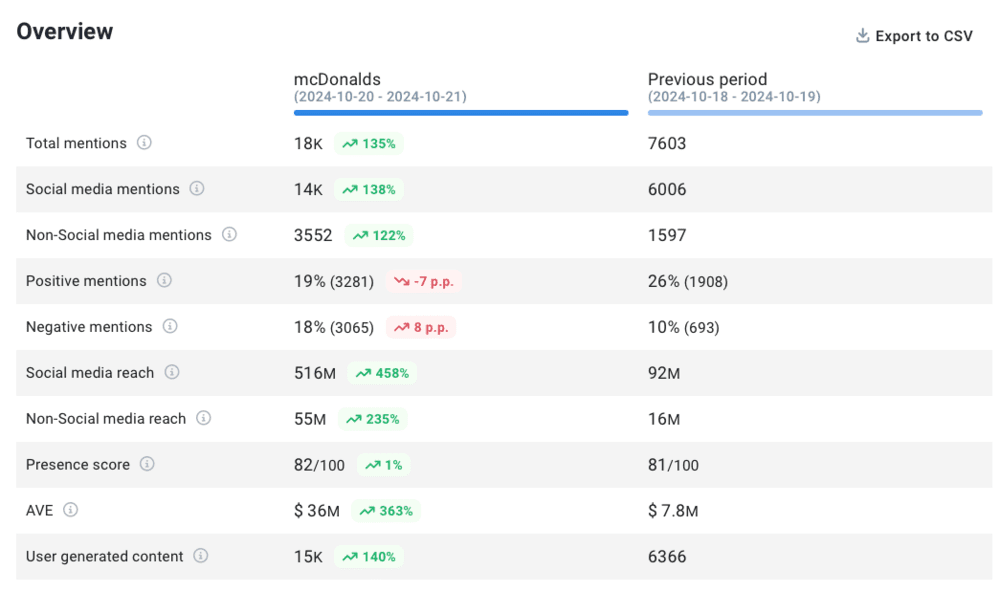
As you can see, McDonald’s collected far more mentions between October 20 and 21, 2024, than in the previous period (October 18 to 19, 2024).
However, that’s not a reason to celebrate yet.
Notice how the number of positive content dropped, and negative content increased.
That’s a terrible sign.
Let’s see how to fix that online reputation and build a positive digital presence.
01 Identify the source of negative content
To start online reputation repair, you need to identify the sources of damage first.
Are your customers complaining on social media platforms, or do some news articles share a negative opinion about your brand? You need to find it out.
It’s difficult to pinpoint the source of negative content on your own.
Processing enormous amounts of negative search results and social media posts would take ages.
Fortunately, media monitoring tools can do it for you.
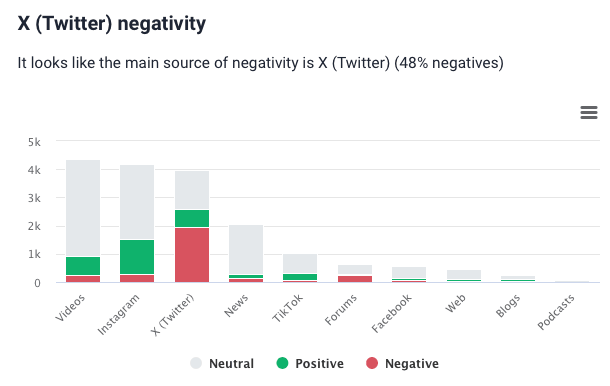
As you can see, in McDonald’s case X (Twitter), Instagram and forums attracted the most negative content.
I used the filtering options to set the date to the period of increased buzz around Trump’s involvement in McDonald’s.

This allowed me to detect the sources of negative search results in the particular period when the controversy occurred.
02 Identify the reason for the reputation damage
Now, it’s time to analyze the topics negatively impacting your brand image.
You need to discover what your target audience is discussing and the sentiments behind those topics.
Online reputation tools like Brand24 monitor and analyze mentions and, based on that data, list the most talked about topics.
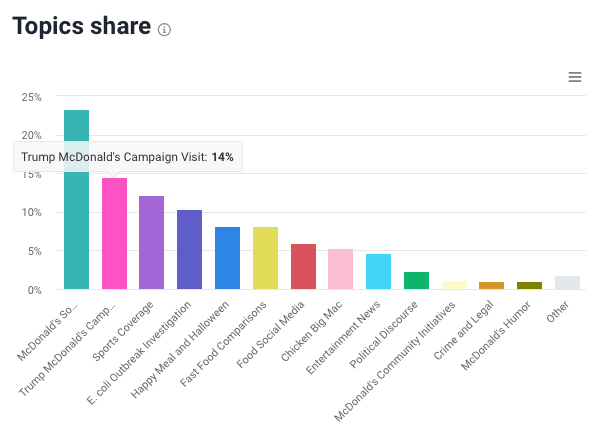
As you can see, the “Trump McDonald’s Campaign Visit” constitutes 14% of all topics around the fast food company in the past 30 days.
Each topic has a sentiment breakdown to help you judge whether it indicates positive or negative emotions.
All you need to do is to find those topics that generate the most negative sentiment.
After doing so, you can dive deeper into the statistics around a particular topic.
For instance, you can check the top mentions with negative links.

You can also do a granular emotion analysis of a topic.
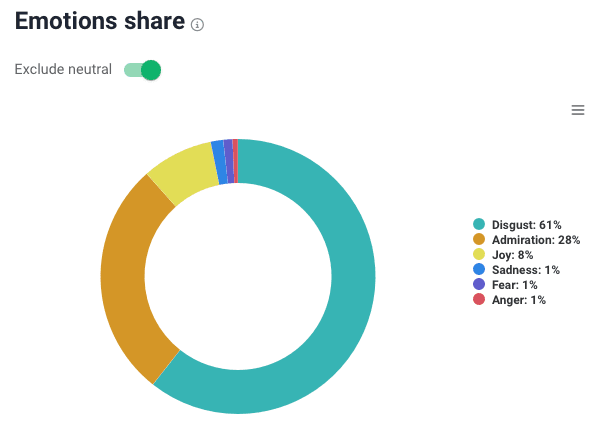
This way, you have all the needed insights to address the issues globally, as you know which topics are the biggest pain points for your target audience.
03 Find negatively speaking influencers
Now that you know where and what topics have damaged your brand’s reputation, it’s time to find the most influential profiles.
Influencers with a significant following shape public perception and can trigger a social media crisis. That’s why communication with them should be a part of your online reputation repair strategy.
Engaging with influencers who speak negatively about your brand is an opportunity to address their concerns directly. Constructive engagement can lead to a resolution or clarification of misunderstandings.
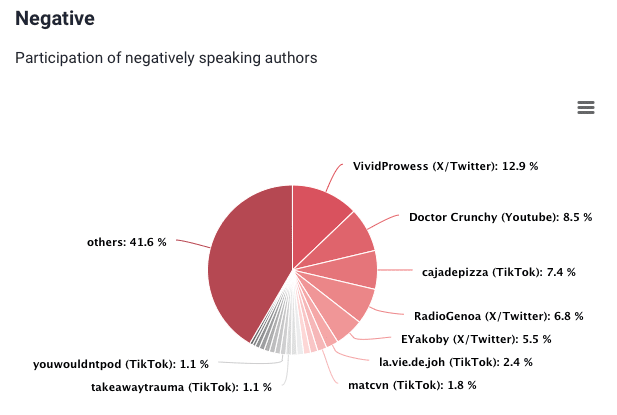
But it continues beyond influencers.
You should also look at less prominent individuals who left relevant negative feedback.
You’ll find them in the Analysis Tab under Top Public Profiles.

Identifying and engaging with negatively speaking influencers is not just about addressing criticisms; it’s an opportunity to understand the broader market sentiment, improve brand perception, and turn critics into brand advocates.
Start online reputation repair!
How to communicate with influencers who negatively mentioned your brand? Tips
- Treat the influencer respectfully and professionally, regardless of their negative content.
- Before responding, understand the influencer’s concerns. Listen to their points and try to understand the context of their negative comments.
- Time counts. Delayed responses can escalate the situation. However, ensure your response is well thought out and appropriate.
- Address concerns directly. If there are misunderstandings, clarify them respectfully. If the brand is at fault, admit it openly and discuss the steps you’re taking to improve.
- After the initial conversation, follow up. Let them know if you’ve taken any action based on their feedback. This shows your commitment to continuous improvement.
04 Track negative reviews
One of the most crucial online reputation repair strategies is review management.
Pay attention to reviews on websites such as TripAdvisor, Yelp, Booking, the App Store, Google Play, and Trustpilot.

Those websites have high influence scores and significantly impact customers’ buying decisions.
Many potential customers read reviews to assess the quality and reliability of a product or service before making a purchase.
Reviews serve as social proof of a brand’s quality and reliability.
A mix of positive and negative reviews, with appropriate responses, can increase a brand’s credibility, showing transparency. Furthermore, Reviews can impact a brand’s visibility on search engines.

How a brand responds to negative reviews can significantly impact public perception.
Professional and constructive responses can mitigate the impact of negative reviews and improve the search engines’ visibility.
Check: Monitor App Store Reviews
05 Respond to the most popular negative mentions
Responding to negative mentions shows that a brand cares about its customers’ opinions.
This significantly impacts public perception and helps maintain a positive online reputation.
Ignoring popular negative mentions can escalate the issue, with more people joining the negative content creation.
Responding can help nip the problem in the bud and maintain a positive reputation.
How to find mentions that can cause a negative reputation?
The best way is to use a tool that automatically detects and analyzes negative content on social media, news articles, blogs, and other online sources.
I filtered the data and found the most relevant negative search results in my monitoring project:

How to respond to popular negative mentions? Tips
- Respond in a timely manner. The longer damaging content goes unaddressed, the more it can escalate and harm your brand.
- Acknowledge the negative content and apologize sincerely to demonstrate responsibility.
- Avoid generic responses. Tailor your reply to show you are genuinely attentive to your customer’s feedback.
- Provide a solution to the problem or explain the steps your brand takes to address the issue.
- Be honest about what you can and cannot do. Transparency builds trust, even in difficult situations.
- Always keep a professional tone. Avoid defensive or confrontational language, as it can exacerbate the situation.
- Follow up publicly once the issue has been resolved. This shows commitment to your word.
- After responding, observe how the situation evolves for a few days. Be ready to engage in further dialogue if necessary.
See also: How to respond to negative reviews?
Following these tips will help you rebuild your company’s online reputation.
06 Address false information
Disinformation always hurts a company’s reputation online. Thus, addressing it before it spreads on the Internet is key.
When responding to fake news, remaining calm and professional is essential. Reacting confrontationally can unintentionally draw more attention to false claims.
How to address false information? Tips
- Develop a response that clearly and factually counters the misinformation. Provide evidence and accurate information to refute the false claims.
- Disseminate your response through various channels where the misinformation has spread. Leverage social media reach for great visibility of your messages.
- If the misinformation comes from a specific source (like individuals, organizations, or press releases), consider engaging with them directly to request a retraction or correction.
- In cases where the false information is particularly damaging or defamatory, seek legal advice to learn about your options for formal recourse.
- Engage with influencers, brand advocates, loyal customers, or past clients who can help disseminate the correct information and support your brand’s message by creating positive content.
- Have a crisis communication plan in place for handling such situations more effectively in the future.
- Monitor the situation continuously to see how it evolves and where it leaves any digital footprint. You can set up a monitoring project for this purpose.
Here’s how Piwik PRO uses a Brand24 tool to fight false or deceptive content.
The team is responsible for monitoring the accuracy and currency of brand-related information, specifically the phrase ‘Piwik PRO.’
If the team encounters misleading online content, such as an outdated description of the product’s functionality, they take action to prevent false content.
The company values compliance with GDPR, privacy, and data security regulations. However, misinformation about the platform’s data collection methods spreading on the web could negatively impact the product’s credibility in users’ eyes.
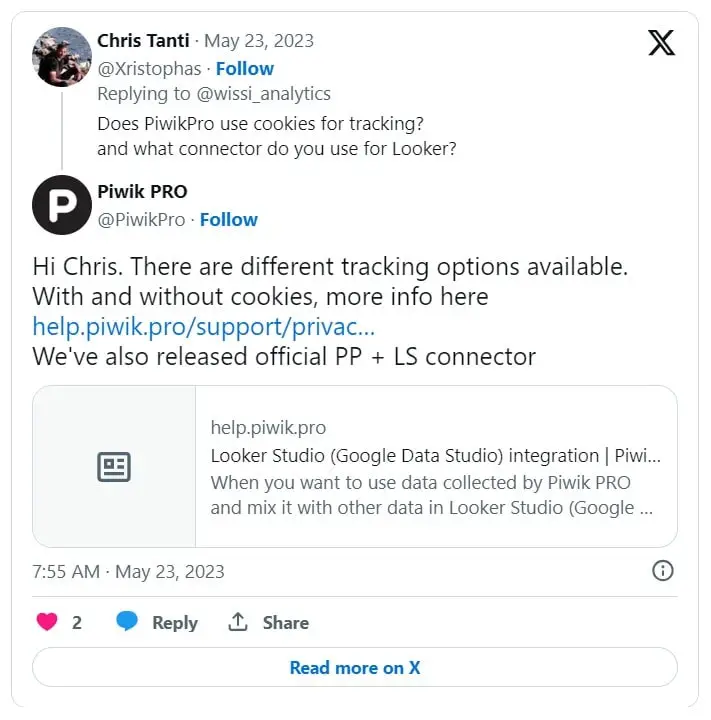
Read the case study: Piwik PRO’s Media Monitoring Strategy
07 Encourage positive reviews
Encouraging positive feedback is a key strategy implemented by online reputation management services.
Positive reviews enhance a brand’s reputation by showing potential customers that existing customers are satisfied with their experiences.

They serve as social proof, strengthening trustworthiness and driving sales.
How to encourage positive reviews? Tips
- Use your social media platforms to encourage satisfied customers to share their experiences. Regularly engage with your audience to foster a community. See also: how to respond to positive reviews.
- Offer incentives for leaving a review, such as discounts or freebies. However, ensure this is done ethically and following the policies of the review platforms.
- Engage with customers after a purchase to ensure they’re satisfied. This is an opportunity to encourage satisfied customers to share their positive experiences online.
- Simplify the review process. Provide direct links to review platforms and clear instructions on how to leave a review. Learn more on how to collect customer feedback here.
Tip: You can also use a reputation management tool to find happy customer testimonials.
08 Ask the AI Brand Assistant for help
An effective strategy is key to your brand reputation repair.
AI Brand Assistant can help you with that, ensuring long-term success.
It’s like ChatGPT but better!
Its advantage is access to social media monitoring results and your brand metrics.
Thus, it knows your brand’s situation on social media sites and relevant websites in search engines.
This way, AI Brand Assistant can give you tips and strategies tailored to your personal online reputation based on your social media and search engine performance.
Take a look at how it works.
Prompt: Prepare an online reputation repair strategy for my brand.
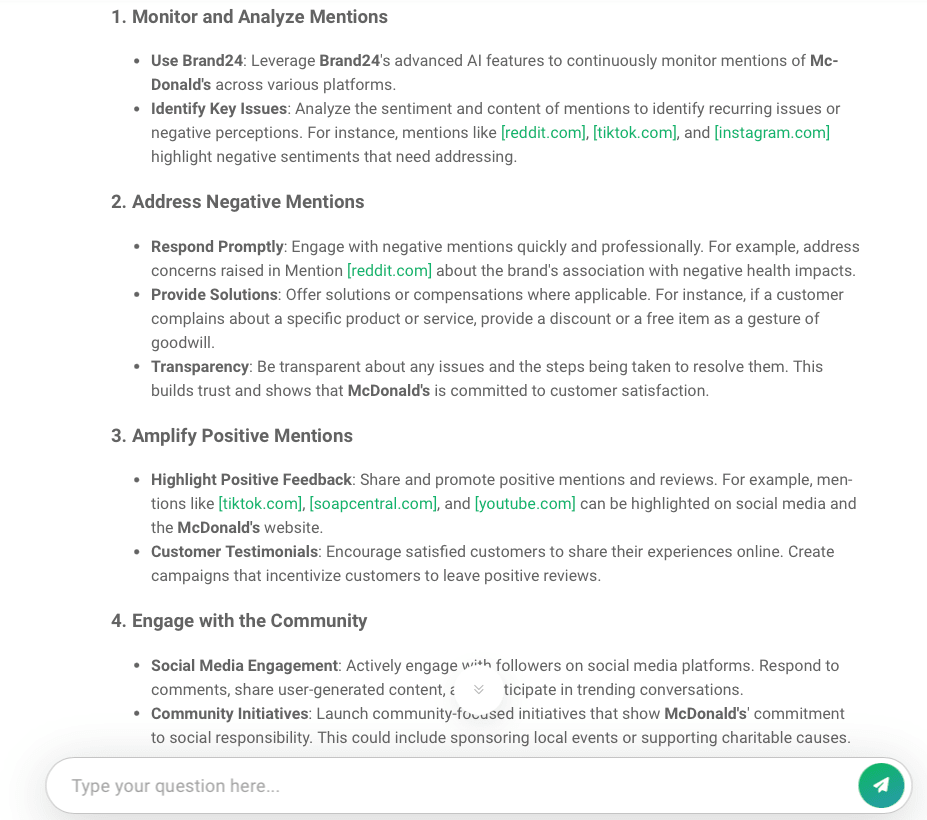
Try AI Brand Assistant now!
Conclusion
In the digital age, your brand’s online image is as crucial as the quality of your products or services. That’s why you should constantly monitor your brand online.
Fortunately, you don’t have to track your online presence manually. There are some great reputation repair services and tools to support your efforts.
With them, you’ll not only conduct online reputation repair but also prevent negative reputation thanks to the early detection of an online reputation issue.
At Brand24, key features to analyze the reputation of your business online are Anomaly Detection and AI Brand Assistant.
Additionally, track Reputation Score, sentiment, and emotion analysis for further digital presence AI insights.
Want to repair your online reputation? Try the best online reputation tool!
Key takeaways:
- Analyze your brand sentiment and emotions online to gain a deeper understanding of your customers’ perceptions.
- Use advanced online reputation management tools to find negative mentions and authors who speak about your company negatively.
- Pay constant attention to online reviews.
- Address false information professionally and calmly.
- Encourage your clients to leave positive reviews to build a positive online presence.




